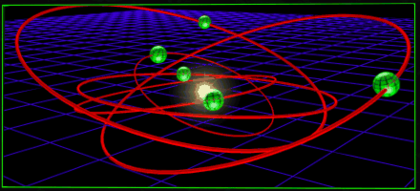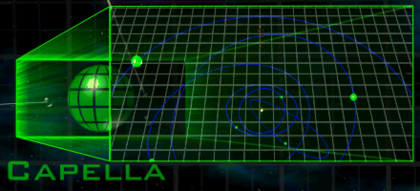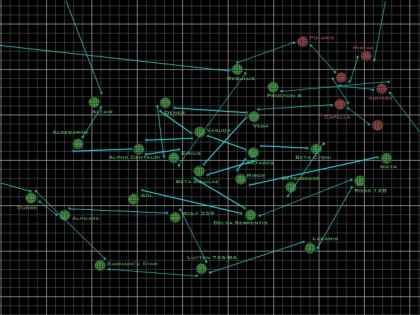Difference between revisions of "Star system"
m (→List of named systems: GTVA --> GTA (This is an FS1-era map)) |
m (Still sounds clumsy.) |
||
| Line 4: | Line 4: | ||
Prior to the development of [[subspace]] travel, space-faring species such as the [[Terran]]s and [[Vasudan]]s were unable to travel outside of their home systems ([[Sol]] and [[Vasuda]] respectively) due to the immense distances between stars. The birthplace of the [[Shivan]]s is unknown; whether they even originated from a star system is open to debate. A mysterious race, now believed to be extinct, known only as the [[Ancients]], allegedly originated in a star system "close to Vasuda". | Prior to the development of [[subspace]] travel, space-faring species such as the [[Terran]]s and [[Vasudan]]s were unable to travel outside of their home systems ([[Sol]] and [[Vasuda]] respectively) due to the immense distances between stars. The birthplace of the [[Shivan]]s is unknown; whether they even originated from a star system is open to debate. A mysterious race, now believed to be extinct, known only as the [[Ancients]], allegedly originated in a star system "close to Vasuda". | ||
| − | With the deployment of subspace travel, various races were able to journey to other systems in a comparatively short space of time. Without subspace, it would take inordinately large amount of time to travel to other systems, as such distances would take years to traverse, even | + | With the deployment of subspace travel, various races were able to journey to other systems in a comparatively short space of time. Without subspace, it would take an inordinately large amount of time to travel to other systems, as such distances would take years to traverse, even at [[light speed]]. |
Certain systems contain planets, which harbor valuable resources, such as minerals or deuterium gas for fueling fusion reactors. Some planets are habitable, enabling the creation of planetary settlements. This has made some star systems extremely prominent, such as [[Capella]]; others, however, are of less use, such as [[Gamma Draconis]], which possesses no planets or moons. | Certain systems contain planets, which harbor valuable resources, such as minerals or deuterium gas for fueling fusion reactors. Some planets are habitable, enabling the creation of planetary settlements. This has made some star systems extremely prominent, such as [[Capella]]; others, however, are of less use, such as [[Gamma Draconis]], which possesses no planets or moons. | ||
| Line 10: | Line 10: | ||
Star systems visited by the Terrans and Vasudans usually have at least one point where intersystem subspace travel is possible. These points are known as [[jump node]]s. The destruction of all jump nodes leading to a system will prevent any subspace travel to or from that system, as was the case with [[Sol]], and later [[Capella]]. Subspace travel within a system is also possible through the use of intrasystem jumps, which any ship equipped with a subspace drive is capable of. | Star systems visited by the Terrans and Vasudans usually have at least one point where intersystem subspace travel is possible. These points are known as [[jump node]]s. The destruction of all jump nodes leading to a system will prevent any subspace travel to or from that system, as was the case with [[Sol]], and later [[Capella]]. Subspace travel within a system is also possible through the use of intrasystem jumps, which any ship equipped with a subspace drive is capable of. | ||
| − | During the [[Second Shivan Incursion]], a notable star system, [[Capella]], was destroyed by a supernova | + | During the [[Second Shivan Incursion]], a notable star system, [[Capella]], was destroyed by a supernova started by a subspace weapon wielded by the [[Shivan]] [[SJ Sathanas|Sathanas]] juggernaut fleet. The purpose of this action, and the means by which it was carried out, remain unknown. |
[[Nebula System|Nebulae]] are vast clouds of interstellar dust which play an important role in the formation of star systems. Although they may not contain any stars or planets, they are also referred to as systems. | [[Nebula System|Nebulae]] are vast clouds of interstellar dust which play an important role in the formation of star systems. Although they may not contain any stars or planets, they are also referred to as systems. | ||
Revision as of 18:28, 13 May 2011


Star systems, commonly referred to simply as "systems", consist of various celestial objects orbiting a star. Star systems may also be host to one or more planets, in which case they may be referred to as planetary systems.
Prior to the development of subspace travel, space-faring species such as the Terrans and Vasudans were unable to travel outside of their home systems (Sol and Vasuda respectively) due to the immense distances between stars. The birthplace of the Shivans is unknown; whether they even originated from a star system is open to debate. A mysterious race, now believed to be extinct, known only as the Ancients, allegedly originated in a star system "close to Vasuda".
With the deployment of subspace travel, various races were able to journey to other systems in a comparatively short space of time. Without subspace, it would take an inordinately large amount of time to travel to other systems, as such distances would take years to traverse, even at light speed.
Certain systems contain planets, which harbor valuable resources, such as minerals or deuterium gas for fueling fusion reactors. Some planets are habitable, enabling the creation of planetary settlements. This has made some star systems extremely prominent, such as Capella; others, however, are of less use, such as Gamma Draconis, which possesses no planets or moons.
Star systems visited by the Terrans and Vasudans usually have at least one point where intersystem subspace travel is possible. These points are known as jump nodes. The destruction of all jump nodes leading to a system will prevent any subspace travel to or from that system, as was the case with Sol, and later Capella. Subspace travel within a system is also possible through the use of intrasystem jumps, which any ship equipped with a subspace drive is capable of.
During the Second Shivan Incursion, a notable star system, Capella, was destroyed by a supernova started by a subspace weapon wielded by the Shivan Sathanas juggernaut fleet. The purpose of this action, and the means by which it was carried out, remain unknown.
Nebulae are vast clouds of interstellar dust which play an important role in the formation of star systems. Although they may not contain any stars or planets, they are also referred to as systems.
